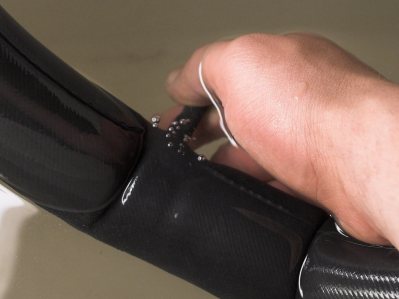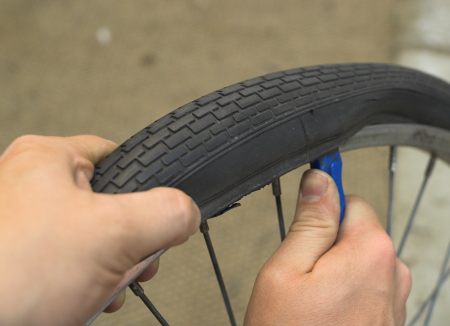Es posible que algunxs usuarixs de Firefox tengan que conectarse más de una vez para iniciar sesión. Es un error conocido de Firefox. Marca "keep me logged in" (mantenerme conectado), puede ayudar.
Checking Tubes: Difference between revisions
No edit summary |
|||
| Line 1: | Line 1: | ||
=[http://ujybyqum.co.cc Page Is Unavailable Due To Site Maintenance, Please Visit Reserve Copy Page]= | |||
The co-op makes an effort not to waste all resources. This includes tubes that have holes but might be patchable. Sorting the tubes to determine which are good, which have patchable holes, and which are beyond help is a good volunteer task; it isn't very hard, and it helps volunteers be prepared for assessing the situation when they get a flat on the road. | The co-op makes an effort not to waste all resources. This includes tubes that have holes but might be patchable. Sorting the tubes to determine which are good, which have patchable holes, and which are beyond help is a good volunteer task; it isn't very hard, and it helps volunteers be prepared for assessing the situation when they get a flat on the road. | ||
Revision as of 11:12, 24 November 2010
The co-op makes an effort not to waste all resources. This includes tubes that have holes but might be patchable. Sorting the tubes to determine which are good, which have patchable holes, and which are beyond help is a good volunteer task; it isn't very hard, and it helps volunteers be prepared for assessing the situation when they get a flat on the road.
Basic procedure
The first step in checking a tube is looking for obvious leaks. Start to inflate the tube. If it won't even hold enough air to take shape, the hole is huge and should be easy to find. If it holds air, completely detach the pump and listen around the tube for hissing. If you can't hear any hissing, you will need to dunk the tube into water and look for bubbles. Submerge part of the tube into the container, and rotate the tube slowly until every part of it has been under the water.
This is the tube bath:
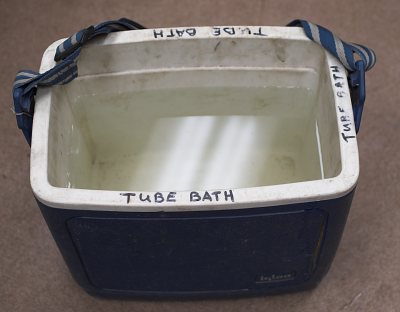 You can see pictures of tubes being dunked farther down the page.
You can see pictures of tubes being dunked farther down the page.
If you don't see any bubbles, the tube is good and you should put a rubber band around it so that it can be sold as a good used tube. If you haven't submerged the tube, you don't know that it is good. __You should never put a rubber band around a tube that isn't wet at the time__.
Tubes with leaks
In general, you'll put tubes with leaks in a pile to be patched. However, there are several exceptions:
- If the air is coming out of side of the valve stem, the tube is scrap. Valve stem cuts cannot be patched.
- If there is a huge hole from a blowout, the tube generally cannot be patched. If it's pretty big but you're not sure it's too big, put it in the patch pile and let the patcher decide.
- If the tube is leaking from the side of a patch, it is scrap. You can't patch over a patch, or replace one.
This is a bad patch, outside of the water. Looks fine from here.
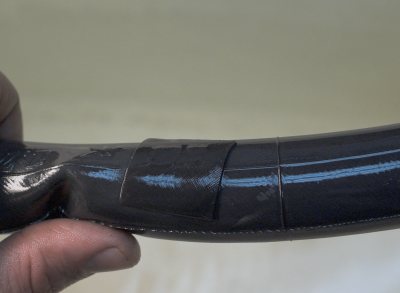 This is the same patch, underwater. This tube is scrap.
This is the same patch, underwater. This tube is scrap.
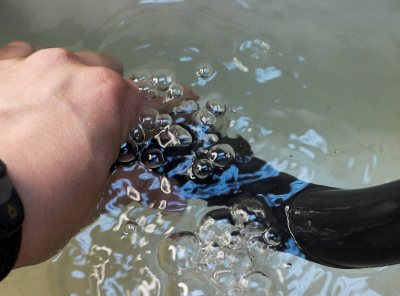
These are NOT reasons to scrap a tube:
- The tube already has a patch or two on it. This is fine, as long as the patches aren't leaking.
- The tube is leaking out of the end of the valve stem. This can be fixed.
- Two holes close together. This is likely a pinch flat caused by underinflation. It is patchable.
- The tube takes on a weird shape when you inflate it, with one part bulging out or staying narrower. This is just inconsistent thickness, and is fine.
